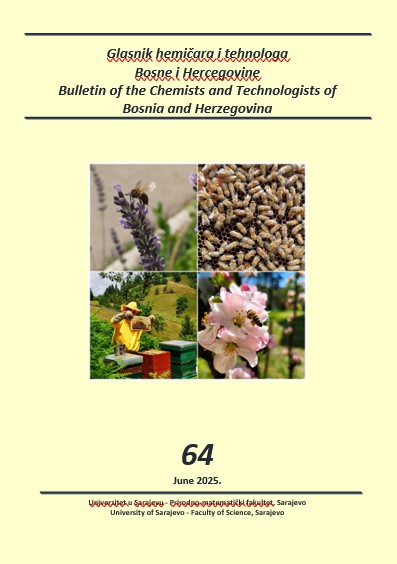|
|
Bulletin of the Chemists and Technologists of Bosnia and Herzegovina
Issue 60
Publication date: June 2023 |
|
Table of contents
Content of Metals in Cow, Sheep and Goat Milk Samples Original Scientific Article
Korać (R), S., Huremović, J., Žero, S., Ljubijankić, N.
DOI: 10.35666/2232-7266.2023.60.01
UDK: 543[637.12:546.3]
Abstract: Milk is an excellent source of many essential nutrients, including Ca, proteins and vitamin D. Nine metals (Ca, Cd, Cu, Fe, Mg, Mn, Zn, Ni and Pb) in raw and pasteurized milk of cow, sheep and goat were determined by atomic absorption spectrometry, flame technique. The levels of Cd, Fe, Mn, Ni and Pb were below the detection limit of the used method. The concentration ranges for Ca, Mg, Zn and Cu, in all milk samples, were as follows: 459.8-992.8, 59.5-206.8, <LOD-22.31 and <LOD-3.20 mg/L, respectively. The order of the metal levels in regards to concentration was Ca>Mg>Zn>Cu. The highest content of Ca and Mg was found in goat milk. In the case of cow's milk, the content of Ca, Mg and Zn increased with increasing amount of milk fat in processed milk. Matrix correlation analysis showed that there is a significant correlation for the following pairs: Ca-Mg (r = 0.830), Zn-Cu (r = 0.799) and Ca-Zn (r = 0.624). Also, a strong correlation was found between milk fat and Ca, Mg and Zn (Pearson factor, r > 0.600). Based on daily consumption of 200 mL of milk, the milk consumption does not meet the daily requirements for determined elements. Most significant intake was in case of Ca.
Bulletin of the Chemists and Technologists of Bosnia and Herzegovina 60, 1-6.
Investigation of Antioxidant Activity of Gallic, Protocatechuic and Vanilic Acid using the Briggs-Rauscher Reaction as Tool Original Scientific Article
Gojak-Salimović, S., Alijagić, N., Ramić, S.
DOI: 10.35666/2232-7266.2023.60.02
Abstract: Hydroxybenzoic acids are an important class of polyphenols because their strong antioxidative activity. In this study, the antioxidant activity of three hydroxybenzoic acids was investigated using the Briggs-Rauscher reaction. Besides individual gallic, protocatechuic, and vanillic acids at concentrations of 250, 500, and 1000 µM respectively, the various mixtures of two and three hydroxybenzoic acids were also tested. The highest antioxidant activity showed protocatechuic acid at a concentration of 1000 µM while the lowest antioxidant activity was observed for vanillic acid at a concentration of 250 µM. The most of investigated hydroxybenzoic acids mixtures showed some degree of antagonistic effect. The highest antagonistic effect was found for the equimolar mixture of protocatechuic and vanillic acid at concentration of 250 μM. On the contrary, the equimolar mixture of gallic acid and vanillic acid at the same concentration indicated a high synergistic effect.
Bulletin of the Chemists and Technologists of Bosnia and Herzegovina 60, 7-12.
Addressing Linguistic and Cultural Heterogeneity in Chemistry Classrooms: Findings from the In-service Teacher Training Program Original Scientific Article
Nuić, I., Mrdić, M., Zejnilagić-Hajrić, M., Dedić Bukvić, E., Mešanović-Meša, E.
DOI: 10.35666/2232-7266.2023.60.03
UDK: 54:371:321[008:81-22]
Abstract: One of the challenges in the teaching science in Bosnia and Herzegovina is its plurality of languages and cultural diversity. In the previous initial teacher education, there was a lack of quality preparation for these modern challenges; opportunities to teach cultural and linguistic diversity were not recognized. Therefore, the challenge is to encourage experienced chemistry teachers to develop competencies for an intercultural teaching environment within the Educating Science Teachers for All (ESTA) project. The participants of the in-service professional development program were chemistry teachers from three cantons in Federation of Bosnia and Herzegovina. The aim of the program was to develop and improve professional competencies through workshops and work in groups, with discussions on selected topics and laboratory exercises with the use of modern laboratory equipment and ICT. Teaching opportunities were offered in linguistically diverse classes, as well as in classes with other forms of student diversity. The results showed that teachers are aware of the need to be sensitized for student differences. They expressed positive impressions and willingness to adjust the teaching material according to the needs of their students, but also the need for further support through collaboration with the university staff.
Bulletin of the Chemists and Technologists of Bosnia and Herzegovina 60, 13-20.
The Influence of Foreign Ions on Determination and Speciation of Cr(VI) and Cr(III) from Water Samples Original Scientific Article
Ramić, E., Žero, S., Memić, M.
DOI: 10.35666/2232-7266.2023.60.04
UDK: 543[628.3:544.344.3]
Abstract: This study reports: a) the content of Ca, Cd, Co, Cr(III), Cr(VI), Cu, Fe, K, Mg, Mn, Na, Ni, Pb, and Zn in wastewater from metal industries and rivers that flow near the metal processing industries; b) the possibility of quantitative determination of Cr(III) and Cr(VI) in the presence of the following cations: Fe3+, Cu2+, Ca2+, Mg2+, Ni2+, Mn2+; and Zn2+ and anions Cl-, NO3-, and SO42-; c) speciation of Cr(III) and Cr(VI) on silica gel modified with Nb2O5 . Metals were determined by flame atomic absorption spectrometry, except for Na and K, which were determined by atomic emission spectrometry, and Cr(VI) by ultraviolet-visible spectrophotometry. When the concentration of cations is higher than Mg2+ (>25 mg/L), Ni2+ (>100 mg/L), Fe3+ (>250 mg/L), Zn2+ (>500 mg/L), and Mn2+ (>1000 mg/L), an error greater than 10 % is obtained in the measurement of Cr(III) . Silica gel modified with Nb2O5 can be considered as an effective solid phase extraction adsorbent for speciation of Cr species and simultaneous concentration of Cr(III). The proposed method was successfully applied to the speciation and determination of Cr(III) and Cr(VI) in the analyzed samples. The content of almost all analyzed metals has been below the permitted values for wastewaters.
Bulletin of the Chemists and Technologists of Bosnia and Herzegovina 60, 21-29.








